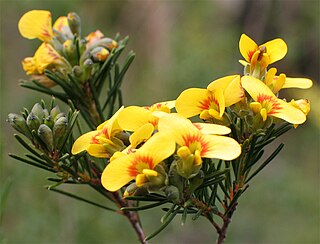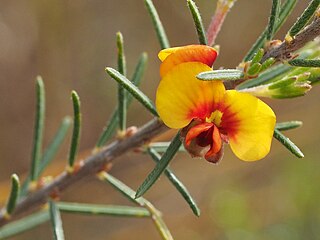
Grevillea rosmarinifolia, commonly known as rosemary grevillea, is a species of flowering plant in the family Proteaceae and is endemic to south-eastern continental Australia and naturalised in other parts of the country. It is usually an erect, compact to open shrub with linear, narrowly elliptic or narrowly oblong leaves with the edges rolled under, and loose clusters of pink to red flowers.

Dillwynia is a genus of about 20 species of flowering plants in the family Fabaceae, and is endemic to Australia. Plants in this genus are shrubs with simple leaves and yellow or red and yellow flowers similar to others in the family.

Dillwynia tenuifolia is a species of flowering plant in the family Fabaceae and is endemic to eastern New South Wales. It is an erect shrub with linear leaves, and orange-yellow and red flowers.

Dillwynia retorta, commonly known as eggs and bacon, is a species of flowering plant shrub in the family Fabaceae and grows in New South Wales and Queensland. It is usually an erect shrub with thin, smooth, crowded leaves and yellow flowers with red markings.

Bossiaea buxifolia, commonly known as matted bossiaea, is a species of flowering plant in the family Fabaceae and is endemic to south-eastern Australia. It is a prostrate to weakly erect shrub with elliptic to egg-shaped or almost round leaves and yellow, red and purplish flowers.

Dillwynia cinerascens, commonly known as grey parrot-pea, is a species of flowering plant in the family Fabaceae and is endemic to south-eastern Australia. It is an erect to low-lying shrub with linear or thread-like leaves and orange or yellow flowers.

Dillwynia sericea, commonly known as showy parrot-pea, is a species of flowering plant in the family Fabaceae and is endemic to south-eastern Australia. It is an erect to low-lying shrub with hairy stems, linear leaves and apricot-coloured flowers, usually with a red centre.

Bossiaea foliosa, commonly known as leafy bossiaea, is a species of flowering plant in the family Fabaceae and is endemic to south-eastern Australia. It is an erect shrub with small, broadly egg-shaped to round leaves, and bright yellow flowers.

Leptospermum multicaule, commonly known as the silver tea-tree, is a species of shrub that is endemic to south eastern Australia. It has linear, narrow elliptical or narrow egg-shaped leaves, white or pink flowers usually borne singly on short side shoots, and fruit the falls from the plant soon after the seeds are released.

Dillwynia glaucula, commonly known as Michelago parrot-pea, is a species of flowering plant in the family Fabaceae and is endemic to south-eastern New South Wales. It is an erect shrub with lenticels on the stems, linear, grooved leaves and yellow flowers with red markings.

Dillwynia hispida , commonly known as red parrot-pea, is a species of flowering plant in the family Fabaceae and is endemic to south-eastern Australia. It is an erect shrub with more or less glabrous stems, linear to thread-like leaves and orange and red, partly crimson flowers.
Dillwynia juniperina, commonly known as prickly parrotpea, is a species of flowering plant in the family Fabaceae and is endemic to south-eastern continental Australia. It is an erect, spreading shrub with rigid, linear, sharply-pointed leaves and yellow flowers with red markings.

Dillwynia prostrata, commonly known as matted parrot-pea, is a species of flowering plant in the family Fabaceae and is endemic to south-eastern continental Australia. It is a prostrate shrub with hairy stems, linear to narrow oblong or spatula-shaped leaves and yellow and dark red flowers.

Dillwynia ramosissima, commonly known as bushy parrot-pea, is a species of flowering plant in the family Fabaceae and is endemic to south-eastern continental Australia. It is a low-lying to erect shrub with linear to narrow oblong or spatula-shaped leaves and yellow flowers with red markings.

Dillwynia sieberi, commonly known as Sieber's parrot-pea, is a species of flowering plant in the family Fabaceae and is endemic to eastern Australia. It is an erect shrub with rigid, needle-shaped, sharply-pointed leaves and yellow to yellow-orange flowers with reddish-brown markings.
Pultenaea canescens, commonly known as plumed bush-pea, is a species of flowering plant in the family Fabaceae and is endemic to a small area in eastern New South Wales. It is an erect shrub with narrow elliptic to narrow egg-shaped leaves, and yellow to orange flowers with reddish-brown markings.

Pultenaea foliolosa, commonly known as the small-leaf bush-pea, is a species of flowering plant in the family Fabaceae and is endemic to eastern Australia. It is an erect to low-lying shrub with elliptic to oblong leaves that are concave on the upper surface, and yellow to orange and reddish-brown flowers.

Pultenaea polifolia, commonly known as dusky bush-pea, is a species of flowering plant in the family Fabaceae and is endemic to south-eastern continental Australia. It is an erect to prostrate shrub with linear or elliptic to egg-shaped leaves with the narrower end towards the base, and yellow to orange and red to purple flowers.

Pultenaea procumbens, commonly known as heathy bush-pea, is a species of flowering plant in the family Fabaceae and is endemic to south-eastern continental Australia. It is a low-lying or spreading shrub with lance-shaped or rhombic leaves and yellow, orange and red flowers.

Pomaderris ledifolia, commonly known as Sydney pomaderris, is a species of flowering plant in the family Rhamnaceae and is endemic to south-eastern continental Australia. It is an erect, delicate shrub with hairy young stems, narrowly elliptic to lance-shaped leaves, and compact clusters of yellow flowers.


















